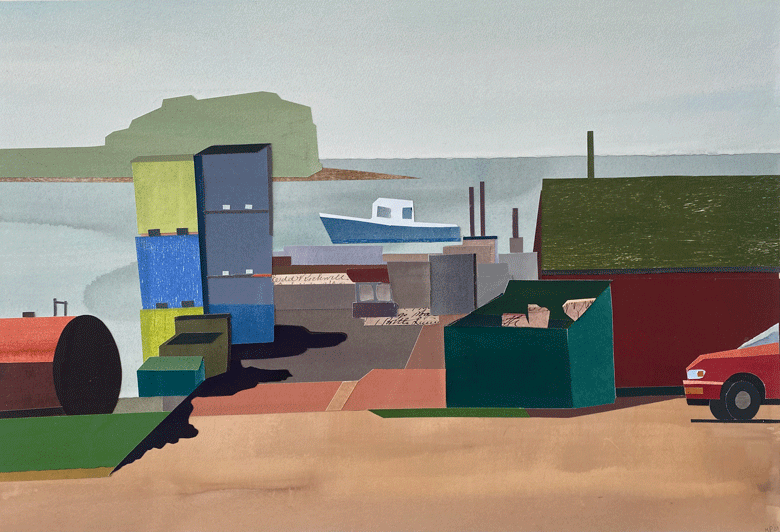While attending St. Andrews Presbyterian College in Laurinburg, N.C. in the late 1960s, Mary Prince drove through Maine on a trip to St. Andrews, New Brunswick.
“I felt immediately that Washington County was the place where I wanted to live,” she recalls. And live there she did: In 1983, the year she and her husband were married, they bought a small farmhouse in Jonesport. Prince has been coming to Jonesport and more recently Addison ever since.
Prince’s collage “Stan Beal’s Wharf, Beals, Maine” exemplifies her love of the working waterfront in her stretch of coast.
One of Prince’s favorite things about painting that wharf is “getting to meet and chat with some of the lobster fishermen…”
“The wharves, boats, and the clusters of small houses hugging the shoreline” are images that give her constant pleasure, she says.
In considering this collage, Prince likens the cluster of abstract shapes with their lively colors to a still life. She celebrates the seemingly random arrangement of “familiar and obscure objects” that surprise her “beyond anything” she could imagine.
Prince’s collages are often a reinvention of her paintings, but they can also be original compositions as she cuts and pastes.
“Collage provides the opportunity to heighten the color and value, simplify the shapes, or change the atmosphere while basically maintaining a similar composition as the painting,” she explains.
Prince paints most of her collage paper with watercolor or gouache. Her favorite paper is Arches MBM, which “takes the paint nicely and lies beautifully flat when glued… and cuts like butter.”
Sean Wolfe has printed woodblock grain for her in assorted colors. The woodblock print provides the opportunity for subtle texture and variety.
Prince could have titled her collage “Barney’s Cove” after its location, but she wanted to pay tribute to Stanley Beal who passed away last year.
“Beal and his family represent a long and rich heritage of Maine lobstermen,” she writes.
Born on Beals Island in 1934, Stan Beal attended local schools before joining the U.S. Air Force. Stationed in Alaska in the late 1950s, he called his father Uriah and said, “Get me a [lobster] boat built,” which led to 20 or so years hauling traps from the F/V Verda Mae. In the early 1990s he leased and then purchased Barney’s Cove Lobster Company and worked there till he was 80.
“Without a doubt,” reads Beal’s obituary, “his favorite thing about working at the wharf was speaking with the fishermen every day about their successes, and sometimes even failures, out on the water.”
And one of Prince’s favorite things about painting that wharf is “getting to meet and chat with some of the lobster fishermen, some of whom have related their family’s history of fishing.”
Born in Virginia’s Blue Ridge Mountains in 1948, Prince was exposed to the ocean while growing up in Virginia Beach and later vacationing at Cape Hatteras.
“When I am on the coast of Maine,” she writes, “it brings back fond childhood memories of living by the sea.”
Painting was Prince’s favorite activity as a child. She recalls her brother giving her oil paints when she was ten or 11 and her mother enrolling her in after-school painting lessons from the time she was eight.
Moving to New York City in 1971, Prince studied abstraction with Nieves Billmyer (1909-1999) who had been a star student at the famous Hans Hofmann School in Provincetown. She later took classes in watercolor and oil painting with John Goodrich and collage with Ken Kewley. Today, she is represented by several Maine galleries, including Littlefield and Artemis. Every summer, she participates in a popup show to benefit the Cape Split Chapel.
Prince loves the landscape of Downeast Maine “with its sky, ocean, trees, rocks, and shadows.” Every time she drives across the Jonesport-Beal’s Bridge, she is reminded of her “deep affection and appreciation for this area of Washington County.”
Islandport Press will publish Carl and David Little’s The Art of Penobscot Bay in the fall.





